Translate this page into:
An efficient modification of the decomposition method with a convergence parameter for solving Korteweg de Vries equations
⁎Corresponding author. muhammad975@hotmail.com (H.O. Bakodah)
-
Received: ,
Accepted: ,
This article was originally published by Elsevier and was migrated to Scientific Scholar after the change of Publisher.
Peer review under responsibility of King Saud University.
Abstract
In the present paper, an efficient modification the convergence parameter based on the Adomian Decomposition Method (ADM) is proposed and investigated for a class of nonlinear evolution equations; specifically, the Korteweg de Vries (KdV) equations. We show that the proposed analysis possesses increased accuracy when compared to the standard ADM. Moreover, the optimal value of such a convergence parameter is determined by minimizing the averaged residual error. For such a convergence parameter value, an approximate solution is found to be closer to the available exact solution than the corresponding approximate solution without a convergence parameter for the same number of solution components. The approach proposed may be readily extended to other nonlinear differential and integral equations.
Keywords
Decomposition methods
Convergence parameter
Evolution equations
Korteweg de Vries equations
1 Introduction
The well-known evolution equations that occur frequently in mathematical physics and shallow water applications can be formulated as
where
is the homogeneous term function;
,
real constants;
and
natural numbers and
are nonnegative integers. The exact solution of Eq. (1) is always very difficult to find (Yusuf et al., 2018) which necessitates the study of its special cases including the Korteweg de Vries (KdV) equation, the Benjamin–Bona–Mahony equation (BBM), the Burger’s equation and the regularized long-wave equation (RLWE) among others. The well-known KdV equation reads
where
is a constant mostly preferred 1 or 6 for solution description, see (Soliman and Abdou, 2008; Syam, 2005; Varley and Seymour, 1998; Wazwaz, 1999; Wazwaz, 2001). Recently, the Adomian decomposition method (ADM) (Adomian, 1983; Adomian, 1986; Adomian, 1988; Adomian, 1991; Adomian and Rach, 1992) has been broadly used in treating a variety of mathematical problems mostly modeled in nonlinear differential and integral equations (Aly et al., 2012; AlQarni et al., 2016; Bakodah, 2012; Bakodah, 2012; Bakodah et al., 2017; Bakodah et al., 2015; Bakodah and Darwish, 2013; Bakodah et al., 2016; Banaja et al., 2017; Bulut et al., 2013); see also (Sabi'u et al., 2018; Ebaid, 2011; Ebaid et al., 2015; Duan and Rach, 2011; Duan et al., 2012; Duan, 2010; Inc et al., 2018; Nuruddeen et al., 2018; Qureshi and Ramos, 2018) for various modifications of the ADM and (Liao, 2010; Rach, 1987; Schiesser, 1994; Abdel-Gawad et al., 2018; Aliya et al., 2018; Ansari et al., 2018; Yusuf et al., 2018; Zhang and Liang, 2016) for other methods for solving various evolution equations, respectively. The main part of the ADM is generating the Adomian's polynomials
with denoting the Adomian's polynomials of degree for the nonlinear term appearing in the considered equation while is the series solution converging to the exact one. Furthermore, in the case of the Adomian's polynomials for multivariable nonlinearities and differential nonlinearities, we have
where is the multivariable nonlinearity of arguments. Again, both the one and multivariable Adomian’s polynomials can respectively be rapidly generated to high orders by algorithms and Mathematica subroutines crafted by Duan (Inc et al., 2018). Moreover, Zhang and Liang (2016) recently proposed a new convergence parameter for the ADM that controls the convergence-region and the rate of the optimal series solution. However, the recent modification of the ADM based on Zhang and Liang (2016) will be proposed in this paper for a class of evolution equations, particularly the KdV equations. Some special test problems of interest would be numerically analyzed by the proposed scheme and provide the error estimate and analysis. The extension of the domain of convergence which provides more accurate approximations can be regarded as the main advantage of the scheme.
2 Analysis of the standard ADM
Considering the linear operators
Eq. (1) can be expressed as
with as the inversion operator of
Applying the above inversion operator coupled to initial data
Eq. (4), we obtain
Thus, the standard ADM offers the following sequential recursion solution of Eq. (1) by decomposing
to infinite series
as
where , are the Adomian polynomials (Adomian, 1983; Adomian, 1986; Adomian, 1988; Adomian, 1991).
3 Analysis of the ADM with a convergence parameter
In this section, the concept of a convergence parameter Zhang and Liang (2016) shall be applied to derive the general recursive scheme of Eq. (1) and later demonstrate its application to solve several special cases in the next section. To begin with, a convergence-control parameter c and an artificial parameter
are introduced to Eq. (4) which reads
One then set
Applying the inversion operator
on Eq. (7)
we get
Now, putting Eq. (8) into Eq. (9) and bringing together the coefficients of like-powers of
we obtain the following recursive scheme:
with the Adomian's polynomials to be computed using
When
= 1 in Eq. (8), the solution
with convergence-parameter c is presented by
Then we calculate an nth-order approximation to the solution as
To extend the domain of convergence or rather obtain more accurate approximations; the value of the parameter
is to be determined using the discrete averaged square residual error defined as (Nuruddeen et al., 2018)
Further, the averaged residual error against the determined value of gives the optimal value of when plotted. We will demonstrate later that the new approach is easily implemented on any symbolic software such as Maple or Mathematica. Also, the optimal value of c is obtained via solving the differential equation
Finally, it can be remarked that the optimal choice of could significantly be improve the convergence region and rate of the series solution. We show the effectiveness of the present approach by investigating certain test KdV and coupled KdV systems.
4 Applications
The present section demonstrates the high-accuracy of presented method by considering certain KdV and coupled KdV systems of type Eq. (1). We will present the numerical results based on our method and demonstrate its accuracy by studying the absolute error and the number of iterations involved.
Consider the KdV equation with the given initial data:
Here, is selected as and consequently Eq. (10) leads to
Using the parameterized recursion scheme in Eq. (10) with the appropriate Adomian polynomials yields the first several solution components as
and so on. Substituting Eqs. (14)–(17) into Eq. (11) gives the solution
, from which it can easily be verified that the closed form solution when
is in this form:
Also, to validate the obtained solutions, the curves of the discrete averaged square residual errors
versus
are shown in Fig. 1. This figure points out that the optimal value of
is about
.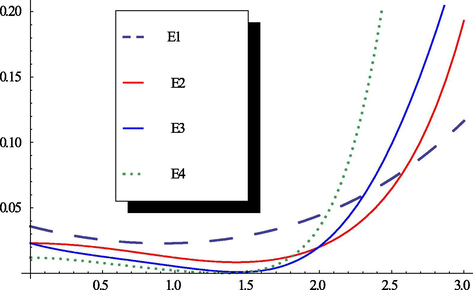
The residual errors at m = 1, 2, 3, 4, and 5.
The results produced by the proposed method are overall more accurate than the standard ADM, as shown in Table 1a.
Present
Standard ADM
Present
Standard ADM
Present
Standard ADM
0.2
0.5
0.6
0.1
0.2
0.3
0.4
0.5
The results in Table 1a reveal that the proposed approach is more accurate than the standard ADM in most cases for the chosen values for and (Fig. 2).
As shown in Table 1a, the numerical results of the proposed method are closer to the values obtained from the analytical solution. Moreover, as shown in Table 1b that the error turned out to be smaller as the number of iterations increased.
To further illustrate the effectiveness of the proposed method, two versions of the modified KdV (mKdV) equations are considered:

- The plots of the exact, proposed method and the ADM solutions, respectively at t = 0.1, 0.5 and 0.7.
| n | ||
|---|---|---|
| 1 | ||
| 2 | ||
| 3 | ||
| 4 |
(i) The first version is given by the following equation
with the initial condition
where is any real constant. On applying the analysis of the previous example, the first several solution components are computed as
and so on. The other calculated terms give the closed form solution when c = 0 as
Fig. 3 gives the plots of the averaged residual errors
against
showing the optimal value of
around 1.001.
The residual errors at m = 1, 2, 3, and 4.
The results produced by our method are put side by side with those obtained by the standard ADM and listed in Table 2. The profile of the solitary wave at
is displayed in Fig. 4.
Present
Standard ADM
Present
Standard ADM
0.3
0.5
0.1
× 10−15
× 10−16
× 10−15
× 10−14
0.2
× 10−15
× 10−16
× 10−15
× 10−14
0.3
× 10−15
× 10−16
× 10−15
× 10−14
0.4
× 10−15
× 10−16
× 10−15
× 10−14
0.5
× 10−15
× 10−16
× 10−15
× 10−14
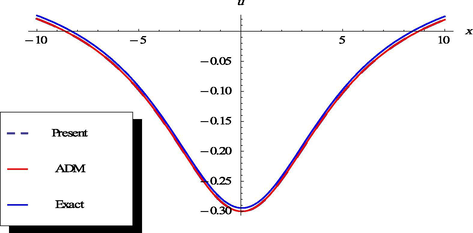
The plots of the exact, proposed method and the ADM solutions, respectively at
.
(ii) The second version of the mKdV equation has the traveling wave solution with the initial data:
with constant and for .
Repeating the previous analysis, we have
and so on. At
the other calculated terms give the following exact solution:
Here also, Fig. 5 gives the plots of the averaged residual errors
against
showing the optimal value of
around 1.03.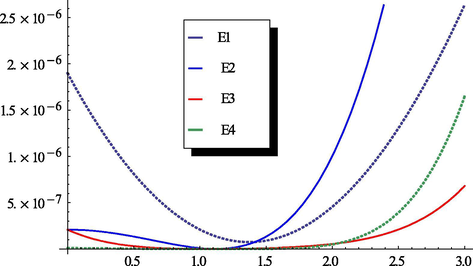
The residual errors at m = 1, 2, 3, and 4.
The results derived by the present method are much better than those obtained by the standard ADM as showed in Table 3. In addition, the profile of the solitary wave at time is compared in Fig. 6.
Consider the combined KdV–mKdV equation
| Present | Standard ADM | Present | Standard ADM | |
|---|---|---|---|---|
| 0.3 | 0.5 | |||
| 0.1 | × 10−10 | × 10−9 | × 10−9 | × 10−8 |
| 0.2 | × 10−10 | × 10−9 | × 10−9 | × 10−8 |
| 0.3 | × 10−10 | × 10−9 | × 10−9 | × 10−8 |
| 0.4 | 4 × 10−10 | × 10−9 | × 10−9 | × 10−8 |
| 0.5 | × 10−10 | × 10−9 | × 10−9 | × 10−8 |
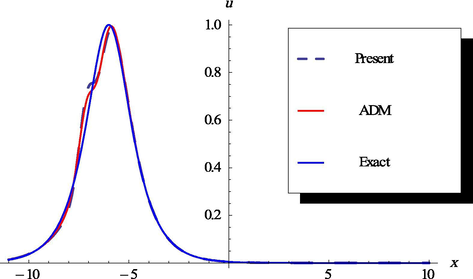
- The plots of the exact, proposed method and the ADM solutions, respectively at t = 1.0.
where and are constants with the following initial data:
We thus obtain the following solitary-wave solution iteratively upon choice of , = 1, as follows:
and so on. The other calculated terms give the closed form solution as
We illustrate the plots of the residual errors
against
with the optimal value of
approaches
in Fig. 7.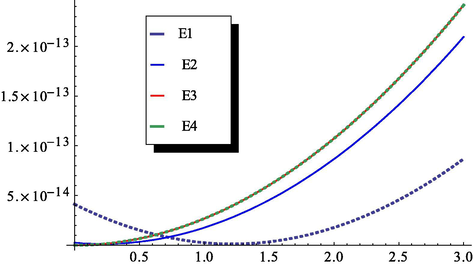
The residual errors at m = 1, 2, 3, and 4.
The results obtained by the proposed scheme are in good conformity with that of the standard ADM, listed in Table 4. In addition, the profiles of the solitary wave at are compared in Figs. 8 and 9.
Here, the coupled mKdV equation is considered as
| Present | Standard ADM | Present | Standard ADM | |
|---|---|---|---|---|
| 0.9 | 1.0 | |||
| 0.1 | × 10−7 | × 10−6 | ||
| 0.2 | × 10−7 | × 10−7 | ||
| 0.3 | × 10−7 | × 10−7 | ||
| 0.4 | 10−7 | × 10−7 | ||
| 0.5 | × 10−7 | × 10−7 | ||
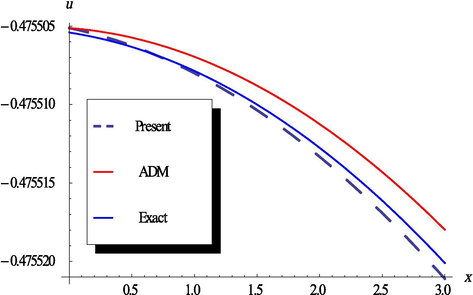
- The plots of the exact, proposed method and the ADM solutions, respectively at t = 0.5.
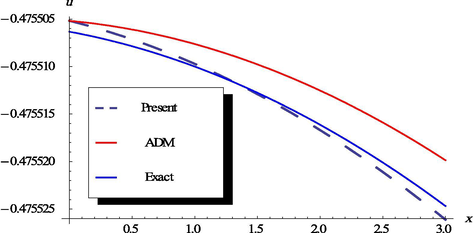
- The plots of the exact, proposed method and the ADM solutions, respectively at t = 1.0.
with initial data
Eq. (24) becomes a generalized KdV equation for and the mKdV equation for , respectively. At this point, we may choose . Therefore using the recursive relation in Eq. (10) and the Adomian's polynomials in Eq. (11) gives the solution components as follows:
and so on. The behavior of the two solutions given by the presented scheme and that of the ADM for certain values of time is depicted and compared with the exact solutions in Figs. 10 and 11. Besides, the exact solutions of
and
were previously given in (Schiesser, 1994) as

The plots of the exact, proposed method and the ADM solution, respectively at t = 0.0, 1.0 and 3.0.

The plots of the exact, proposed method and the ADM solution, respectively at t = 5.0, 7.0 and 10.0.
5 Conclusion
In conclusion, we have proposed a method based on the recent modification of Adomian decomposition method (ADM) by Zhang and Liang to numerically solve several evolution equations with nonlinearities; particularly the Korteweg de Vries equations. This modification depends on embedding a convergence parameter in the Adomian components. The obtained approximate solutions have been compared to the solutions of the classical AD with the aid of the Mathematica software. The investigated examples show that better accuracy was achieved by the proposed method when compared with those by the ADM for the same number of solution components. The proposed scheme should be considered for extension to other classes of partial differential equations arising in engineering applications.
References
- On multi-fusion solitons induced by inelastic collision for quasi-periodic propagation with nonlinear refractive index and stability analysis. Mod. Phys. Lett. B 20181850353
- [Google Scholar]
- Development of a nonlinear hybrid numerical method. Advan. Differential Equa. Control Processes. 2018;19:257-285.
- [Google Scholar]
- Error bounds for a numerical scheme with reduced slope evaluations. J. Appl. Enviro. Biolog. Sci.. 2018;8:67-76.
- [Google Scholar]
- Stochastic Systems. New York: Academic Press; 1983.
- A new approach to the heat equation–an application of the decomposition method. J. Math. Anal. Appl.. 1986;113:202-209.
- [Google Scholar]
- A review of the decomposition method in applied mathematics. J. Math. Anal. Appl.. 1988;135:501-544.
- [Google Scholar]
- Solving frontier problems modelled by nonlinear partial differential equations. Comput. Math. Appl.. 1991;22:91-94.
- [Google Scholar]
- Advances in the Adomian decomposition method for solving two-point nonlinear boundary value problems with Neumann boundary conditions. Comp. Math. Appl.. 2012;63:1056-1065.
- [Google Scholar]
- Optical solitons with coupled nonlinear Schrodinger’s equation in birefringent nano-fibers by Adomian decomposition method. J. Comput. Theor. Nanoscience. 2016;13:5493-5498.
- [Google Scholar]
- A comparison study between a Chebyshev collocation method and the Adomian decomposition method for solving linear system of Fredholm integral equations of the second kind. JKAU Sci.. 2012;24:49-59.
- [Google Scholar]
- Some modifications of Adomian decomposition method applied to nonlinear system of Fredholm integral equations of the second kind. Int. J. Contemp. Math. Sci.. 2012;7:929-942.
- [Google Scholar]
- Decomposition method for solving Burgers’ Equation with Dirichlet and Neumann boundary conditions. Optik. 2017;130:1339-1346.
- [Google Scholar]
- Optical solitons in birefringent fibers with Adomian decomposition method. J. Comput. Theor. Nanoscience. 2015;12:5846-5853.
- [Google Scholar]
- Solving Hammerstein type integral equation by new discrete Adomian decomposition methods. Math. Problems Eng. 2013:1-5.
- [Google Scholar]
- Error estimates of nonlinear algebraic equations by modified Adomian decomposition method. J. Comput. Theor. Nanoscience. 2016;13:1-6.
- [Google Scholar]
- The investigation of optical solitons in cascaded system by improved Adomian decomposition scheme. Optik. 2017;130:1107-1114.
- [Google Scholar]
- Bulut, H., Belgacem, F.B.M., Baskonus, H.M., 2013. Partial fractional differential equation systems solutions by Adomian decomposition method implementation. In: 4th International Conference on Mathematical and Computational Applications (ICMCA), Manisa, Turkey.
- A new analytical and numerical treatment for singular two-point boundary value problems via the Adomian decomposition method. J. Comput. Appl. Math.. 2011;235:1914-1924.
- [Google Scholar]
- An advanced study on the solution of nanofluid flow problems via Adomian’s method. Appl. Math. Lett.. 2015;46:117-122.
- [Google Scholar]
- A new modification of the Adomian decomposition method for solving boundary value problems for higher order nonlinear differential equations. Appl. Math. Comput.. 2011;218:4090-4118.
- [Google Scholar]
- On the effective region of convergence of the decomposition series solution. J. Algorithms Comput. Technol.. 2012;7:227-247.
- [Google Scholar]
- An efficient algorithm for the multivariable Adomian polynomials. Appl. Math. Comput.. 2010;217:2456-2467.
- [Google Scholar]
- Investigation of the logarithmic-KdV equation involving Mittag-Leffler type kernel with Atangana-Baleanu derivative. Physica A. 2018;506:520-531.
- [Google Scholar]
- An optimal homotopy-analysis approach for strongly nonlinear differential equations. Commun. Nonlinear. Sci. Numer. Simulat.. 2010;15:2003-2016.
- [Google Scholar]
- A review of the integral transforms-based decomposition methods and their applications in solving nonlinear PDEs. Palestine J. Math.. 2018;7:262-280.
- [Google Scholar]
- L-stable explicit nonlinear method with constant and variable step-size formulation for solving initial value problems. Int. J. Nonlinear Sci. Numer. Simula 2018
- [Google Scholar]
- On the Adomian (decomposition) method and comparisons with Picard’s method. J. Math. Anal. Appl.. 1987;128:480-483.
- [Google Scholar]
- New exact solution for the (3+1) conformable space–time fractional modified Korteweg–de-Vries equations via Sine-Cosine Method. J. Taibah Univ. Sci. 2018
- [Google Scholar]
- Method of lines solution of the Korteweg-de Vries equation. Comput. Math. Appl.. 1994;28:147-154.
- [Google Scholar]
- The decomposition method for solving the coupled modified KdV equations. Math. Comp. Model.. 2008;47:1035-1041.
- [Google Scholar]
- Adomain decomposition method for approximating the solution of the Korteweg-de Vries equation. Appl. Math. Comput.. 2005;162:65-73.
- [Google Scholar]
- Simple derivation of the N-Soltion solutions to the Korteweg-de Vries equation. SIAM J. Appl. Math.. 1998;58:904-911.
- [Google Scholar]
- A reliable modification of Adomian decomposition method. Appl. Math. Comput.. 1999;102:261-270.
- [Google Scholar]
- Blow-up for solutions of some linear wave equations with mixed nonlinear boundary conditions. Appl. Math. Comput.. 2001;123:133-140.
- [Google Scholar]
- Fractional solitons for the nonlinear Pochhammer-Chree equation with conformable derivative. J. Coupled Syst. Multiscale Dyn.. 2018;6:158-162.
- [Google Scholar]
- Solitons and conservation laws for the (2+1)-dimensional Davey-Stewartson equations with conformable derivative. J. Adv. Phys.. 2018;7:167-175.
- [Google Scholar]
- A New Analytic Method with a Convergence-control Parameter for Solving Nonlinear Problems. Cornell University Lib.; 2016. arXiv:1609.01550v1 [Math.NA]







